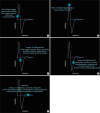1. Sala F. Intraoperative neurophysiology is here to stay. Childs Nerv Syst. 2010; 26:413–417.

2. Riddell V. Thyroidectomy: prevention of bilateral recurrent nerve palsy. Results of identification of the nerve over 23 consecutive years (1946–69) with a description of an additional safety measure. Br J Surg. 1970; 57:1–11.

3. Barczyński M, Konturek A, Cichoń S. Randomized clinical trial of visualization versus neuromonitoring of recurrent laryngeal nerves during thyroidectomy. Br J Surg. 2009; 96:240–246.

4. Randolph GW, Dralle H, Abdullah H, Barczynski M, Bellantone R, Brauckhoff M, et al. Electrophysiologic recurrent laryngeal nerve monitoring during thyroid and parathyroid surgery: international standards guideline statement. Laryngoscope. 2011; 121:Suppl 1. S1–S16.

5. Schneider R, Sekulla C, Machens A, Lorenz K, Thanh PN, Dralle H. Dynamics of loss and recovery of the nerve monitoring signal during thyroidectomy predict early postoperative vocal fold function. Head Neck. 2016; 38:Suppl 1. E1144–E1151.

6. Kim HY, Tufano RP, Randolph G, Barczyński M, Wu CW, Chiang FY, et al. (KINMoS). Impact of positional changes in neural monitoring endotracheal tube on amplitude and latency of electromyographic response in monitored thyroid surgery: results from the porcine experiment. Head Neck. 2016; 38:Suppl 1. E1004–E1008.
7. Loch-Wilkinson TJ, Stalberg PL, Sidhu SB, Sywak MS, Wilkinson JF, Delbridge LW. Nerve stimulation in thyroid surgery: is it really useful? ANZ J Surg. 2007; 77:377–380.

8. Sitges-Serra A, Fontané J, Dueñas JP, Duque CS, Lorente L, Trillo L, et al. Prospective study on loss of signal on the first side during neuromonitoring of the recurrent laryngeal nerve in total thyroidectomy. Br J Surg. 2013; 100:662–666.

9. Carlander J, Wagner P, Gimm O, Nordenström E, Jansson S, Bergkvist L, et al. Risk of complications with energy-based surgical devices in thyroid surgery: a national multicenter register study. World J Surg. 2016; 40:117–123.

10. Whitfield PC, Kirkpatrick P. Timing of surgery for aneurysmal subarachnoid haemorrhage. Cochrane Database Syst Rev. 2001; CD001697.

11. Tator CH. Review of treatment trials in human spinal cord injury: issues, difficulties, and recommendations. Neurosurgery. 2006; 59:957–982.
12. Wilson L, Lin E, Lalwani A. Cost-effectiveness of intraoperative facial nerve monitoring in middle ear or mastoid surgery. Laryngoscope. 2003; 113:1736–1745.

13. Dralle H, Sekulla C, Lorenz K, Brauckhoff M, Machens A; German IONM Study Group. Intraoperative monitoring of the recurrent laryngeal nerve in thyroid surgery. World J Surg. 2008; 32:1358–1366.

14. Kim HY, Liu X, Sun H, Wu CW, Chai YJ, Chung WY, et al. Medico-legal issues of intraoperative neuromonitoring in thyroid surgery. J Endocr Surg. 2017; 17:42–56.

15. Dralle H, Schneider R, Lorenz K, Phuong NT, Sekulla C, Machens A. Vocal cord paralysis after thyroid surgery: current medicolegal aspects of intraoperative neuromonitoring. Chirurg. 2015; 86:698–706.
16. Dralle H. Surgical assessment of complications after thyroid gland operations. Chirurg. 2015; 86:70–77.
17. Dralle H, Lorenz K, Machens A. Verdicts on malpractice claims after thyroid surgery: emerging trends and future directions. Head Neck. 2012; 34:1591–1596.

18. Dionigi G, Bartolo V, Rizzo AG, Marullo M, Fabiano V, Catalfamo A, et al. Improving safety of neural monitoring in thyroid surgery: educational considerations in learning new procedure. J Endocr Surg. 2018; 18:21–36.

19. Dionigi G, Sun H, Chai YJ, Catalfamo A, Mangraviti A, Rizzo GA, et al. Bilateral vocal palsy after total thyroidectomy: expert opinion on two malpractice claims. J Endocr Surg. 2017; 17:139–148.

20. Wang T, Kim HY, Wu CW, Rausei S, Sun H, Pergolizzi FP, et al. Analyzing cost-effectiveness of neural-monitoring in recurrent laryngeal nerve recovery course in thyroid surgery. Int J Surg. 2017; 48:180–188.

21. Sanabria Á, Ramírez A. Economic analysis of routine neuromonitoring of recurrent laryngeal nerve in total thyroidectomy. Biomedica. 2015; 35:363–371.
22. Rocke DJ, Goldstein DP, de Almeida JR. A cost-utility analysis of recurrent laryngeal nerve monitoring in the setting of total thyroidectomy. JAMA Otolaryngol Head Neck Surg. 2016; 142:1199–1205.

23. Al-Qurayshi Z, Kandil E, Randolph GW. Cost-effectiveness of intraoperative nerve monitoring in avoidance of bilateral recurrent laryngeal nerve injury in patients undergoing total thyroidectomy. Br J Surg. 2017; 104:1523–1531.






 PDF
PDF ePub
ePub Citation
Citation Print
Print



 XML Download
XML Download